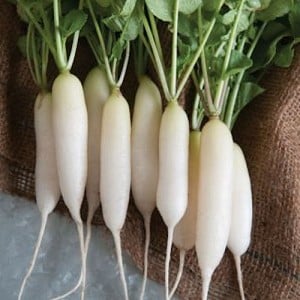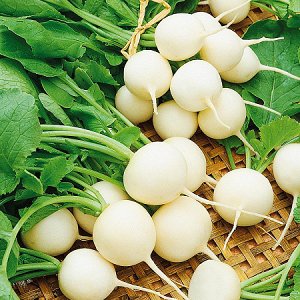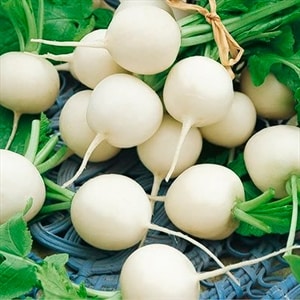What is special about white radishes: description and characteristics of varieties
Most often on the shelves of shops and markets you can find the familiar radish with red and pink colors. However, varieties with white fruits are winning more and more fans with their mild taste.
In the article you will find information about how exactly white radishes differ from red ones, how to grow them correctly and how to use them.
Description of culture
Radish belongs to the cruciferous family and is considered the closest relative of another spicy root vegetable - radish. In Southeast Asia and the Mediterranean, the vegetable has been cultivated for several millennia.
For the first time, radishes were brought to Russia only in the 18th century from France, so the curiosity was called “French radish.”
White radish belongs to the same type of plant as the usual red one, namely, the seed radish.
White radish varieties

White-fruited radishes cannot yet boast the same variety of varieties as red ones.
However, even among white-colored root vegetables there are samples that differ from each other in shape, ripening time and nuances of taste.
White Fang
The miniature fruit of an elongated conical shape reaches only 4 cm in length. This radish tastes sharp, with a characteristic bitterness. It is cultivated only in open ground.
Firefly
Mid-season variety. The root vegetables are small, up to 10 cm in length, and shaped like an icicle. There is a sweet note in the taste. Suitable for cultivation in greenhouses and open ground.
Alba
Belarusian mid-season, productive variety. The fruit has a cone-shaped shape, covered with a snow-white and thin peel. It has good keeping quality and resistance to shooting.
Ice icicle
A late-ripening variety, named due to the characteristic shape of the root crop, reaching 15 cm in length. Harvest is harvested 35-40 days after landings. It has juicy and crispy flesh. Suitable for growing both in open ground and in a greenhouse.
Virovsky white
It is distinguished by the classic round shape of the root crop, about 4 cm in diameter. The pulp is practically devoid of sharpness and does not become flabby for a long time during storage.
Intended for open ground, the crop is harvested 26-33 days after emergence (mid-season variety).
Daikon
It is often called Japanese or Chinese radish, as it is widely used in Asian cuisine, especially when pickled. Strictly speaking, daikon is distantly related to radish, but it still belongs to the same plant species - Radish.
Depending on the specific variety, daikon can take on a conical, cylindrical, more square or rounded shape. The vegetable differs from ordinary white radishes in its large size - individual representatives grow up to 40 cm in length and weigh about 5 kg. In addition, daikon leaves are dissected, and the pulp does not taste bitter due to the small amount of mustard oil.
Chemical composition, trace elements, vitamins and beneficial properties
White radishes are rich in fiber and contain only 15 kcal per 100 g of product, which makes the vegetable an indispensable assistant in weight loss. The same portion of the plant supplies the body with:
- 32% of the daily value of ascorbic acid (vitamin C);
- 11% - potassium;
- 10% - copper.
Other beneficial substances include:
- vitamins E, PP, group B;
- macroelements (sodium, magnesium, calcium);
- iron salts;
- nitrogenous compounds and ash substances;
- natural sugars.
Thanks to this composition, radishes:
- increases immunity and helps with vitamin deficiency;
- improves metabolic processes, intestinal motility and normalizes cholesterol;
- has a slight choleretic and diuretic effect, used to relieve swelling;
- useful for anemia.
The vegetable is contraindicated for diseases of the digestive tract (ulcers, gastritis, colitis, pancreatitis) and problems with the thyroid gland. People who have had a heart attack, children under 3 years of age, and pregnant and lactating women should not abuse the product.
Reference. Used as food not only root vegetables, but also young greens. The plant is used fresh, pickled or after heat treatment as a side dish for meat or a component of hot dishes.
For which regions is it best suited and what are the climate requirements?
Due to its frost resistance, white radishes show high yields in areas with close to extreme agroclimatic conditions: in the North and Siberia.
In the middle zone and the Central Black Earth region, it is possible to harvest several vegetable crops per season, but prolonged heat negatively affects the performance. It is easiest to regulate the level of humidity, light and temperature in greenhouses and greenhouses.
The main advantages and disadvantages of white radishes
White radishes compare favorably with their colored counterparts in that:
- Retains the taste and elastic texture of the pulp longer.
- It has a more delicate taste than red varieties.
- It does not contain coloring substances from the group of glycosides - anthocyanins, which color the peel brightly and can cause unwanted reactions in humans, therefore it is more suitable for dietary nutrition.
- It has a short growing season, so you can grow several crops per season.
White varieties have only one drawback, a very conditional one: the delicate taste may disappoint lovers of spicy radishes.
Features of planting and growing in a greenhouse and in open ground
Radishes are cold-resistant and unpretentious crops that easily tolerate spring frosts. This vegetable is one of the first to ripen, appearing on the summer resident’s table in May-June.
Preparing for landing
It is advisable to prepare the bed in the fall: dig up the soil, remove weeds and fertilize the soil. As a supplement for winter choose mineral fertilizers - superphosphate and potassium chloride - or rotted compost. By spring, nutrients are converted into easily digestible forms.
Immediately before sowing, nitrogen-containing fertilizers are applied to the soil: urea, manure, etc.
Reference. To ensure that the seeds germinate faster and the plant develops faster, the prepared beds can be watered with a warm solution of sodium humate.
Seed material is disinfected by soaking for half an hour in a pink solution of potassium permanganate, then dried on gauze or other soft material. Some gardeners pre-harden the seeds: heat them for 15 minutes in hot water, immediately cool them in cold water, and then put them in the refrigerator for a day.
Soil requirements
White radish is not picky about soil, although it prefers loose, well-ventilated sandy or loamy soils. Heavy clay soils are balanced with sand or peat. In addition, the plant does not tolerate soil acidification well, so the soil is limed in the fall.
With a lack of nutrients, especially potassium, radishes practically do not form roots, so they require careful soil preparation before planting.
Ideal predecessors for radishes are cucumbers, tomatoes, onions, potatoes or garlic.
Reference. Particular attention is paid to choosing a site for planting. Long-term shading of the bed is not allowed, as radishes are sensitive to lack of light.
Dates, scheme and rules of planting

Radishes are planted in open ground when the snow has melted and the soil has warmed to +3°C. Seeds are planted in grooves 2 cm deep, observing a step of 4-7 cm.
The top is covered with a dry soil mixture - garden soil, humus and sand in a ratio of 2:2:1. The top layer of soil can be lightly compacted and be sure to water it generously but carefully with warm water.
In warm weather, seedlings appear on the fifth day after planting. The growth of root crops begins in 1.5-2 weeks.
Radishes are sown under film in early April, while the sun is not too active. On warm, windless days, the shelter is removed, giving the plant the opportunity to “breathe.”
Reference. The soil warms up faster under a black film than under a transparent one.
To harvest the first harvest in early May, radishes are planted in March using the seedling method. Sprouts can be planted in open ground or a greenhouse when the seedlings already have several leaves - this usually takes 10-15 days after planting.
Features of cultivation
For the full development of tops and root crops, a temperature of +10 to +18°C and good lighting are required.At the same time, radishes relatively prefer short daylight hours, so they are planted in the spring or in the second half of summer. With prolonged exposure to the sun, the plant forms flower stalks.
If green shoots stretch out, this indicates a lack of lighting. The situation can be corrected by hilling the furrow and ensuring maximum access of light to the garden bed. This requires regularly weeding not only at the planting site, but also between the rows.
Watering mode
Radishes love even, frequent and abundant watering. Moisten the soil to a depth of at least 7-10 cm, and if the root crop is long - 20-30 cm. The frequency of watering depends on weather conditions: in moderate summer temperatures, once every 2-3 days is enough, and in hot weather and drought. You will need to water the beds every day in the morning and evening.
Loosening the soil and weeding
Weeding is carried out twice:
- for the first time - a week after germination, to a depth of 5 cm;
- in the second - another week, by 7-10 cm.
Loosen the soil carefully so as not to damage the root system of the plant. Weeds are removed before they become firmly established in the ground, so as not to accidentally pull out the developing root crops. Weeding provides radishes with an uninterrupted supply of oxygen, solar heat and light.
Top dressing
Applying fertilizers before sowing is enough to avoid root feeding during the growing season. Excess nitrogen fertilizers provoke excessive growth of green mass to the detriment of root crops.
If the soil is depleted and contains little humus, you can feed it with “green tea” - a fermented infusion of dandelion and nettle leaves.
Disease and pest control
White radishes are susceptible to fungal diseases such as:
- Kila - growths form on the root crops, the pulp begins to turn brown and rot.
- Powdery mildew - manifests itself in the form of a white, gradually darkening coating on the leaves. The tops dry out and the plant stops developing.
- Gray rot - root vegetables become covered with brown spots and a velvety gray coating.
Diseases spread mainly through fresh manure or contaminated soil, so before sowing it is useful to add wood ash (100 g per sq. m) to the soil and avoid fertilizing with unrotted organic matter. Favorable conditions for the activation of fungal spores are cold summers with prolonged rains and stagnant water in the beds. For prevention purposes, follow the rules of crop rotation, loosen the rows and timely weeding.
At the first signs of disease, plants are treated with lime milk, copper sulfate solution and industrial fungicides.
Among insect pests, the most dangerous are white radishes. wireworm (the larva of the click beetle), eating deep passages in the juicy pulp of the root crop, and cruciferous flea beetle - a lover of eating young green shoots. Pest control includes the use of insecticides or folk remedies. For example, spraying with a soap solution with the addition of ash or tobacco.
Harvest and storage
A trial harvest is possible as early as the 20th day. If the root crops are ripe, do not delay harvesting them, as the plant may enter the flowering and seed formation phase.
At the end JulyWhen the day begins to wane, you can plant radishes a second time.
The collected radishes are cleaned of adhering soil, dried and stored in a cool place: refrigerator or cellar.
Reference. Some varieties, such as Autumn Giant, retain their dense texture and flavor for up to five months.
What difficulties may there be when growing
If the vegetable is not provided with optimal conditions growing, the radish goes into extreme survival mode - all the plant’s forces are directed to the formation of a flower arrow instead of root vegetables.
The crop does not tolerate dense planting. The tops begin to stretch upward, and the crowded roots grow twisted and hollow inside.
With insufficient watering, root vegetables become hard and hollow, and bitterness accumulates in them. On the contrary, waterlogging of the soil leads to cracking of the pulp.
Advice from experienced gardeners

Growing such radishes is new to many, so it’s worth listening to experienced vegetable growers:
- In order not to resort to dangerous chemicals, it is recommended to repel insects with the strong smell of tobacco dust or garlic infusion.
- Planting radishes in a bed where other cruciferous vegetables were previously grown: cabbage, radishes and turnips reduces the immunity of radishes.
- When watering young plants, be especially careful not to erode the soil and expose the subcotyledon. Otherwise, root crops are not formed or take an ugly shape.
Reviews of white radish varieties
Many summer residents, having once tried white radishes, remain faithful to them for many years. Here are a few examples of typical reviews:
Elena, Samara: «My stomach does not react well to the bitter skin of red radishes, so when preparing okroshka I always had to peel it off. I tried the Alba variety. I planted them in a greenhouse in early spring, before the snow melted, and the seeds sprouted quickly and were ripe within a month.I was surprised how thin the skin of this radish is! The pulp itself is juicy, tender and tasty. Now I won’t go back to the red-skinned varieties.”
Lyudmila, Moscow: “I was pleased with the daikon variety Elephant Tusk. It is easy to care for, we even plant it in a free space after harvesting other vegetables, it grows quickly, and one tuber is enough for a whole salad. It can be stored in the basement for 2-3 months. For me it tastes better than radishes.”
Alexander, Belgorod: "My favorite radish is Mokhovsky. The fruits are stored well in a plastic bag in the bottom compartment of the refrigerator. They don’t become flabby for a month and a half and remain juicy. I sow at the earliest possible date or at August, since radishes are not afraid of frost. If a flower sprouts, I don’t throw away the seeds; they remain viable for 4-5 years.”
Conclusion
White radishes have undoubted advantages over red ones: due to the absence of coloring substances, they are more suitable for dietary nutrition, have a mild taste and retain freshness longer. In addition, the agricultural technology of the vegetable is simple and will not cause problems even for a novice gardener.
Early ripening varieties will come in handy during the period of spring vitamin deficiency and diversify the usual diet.